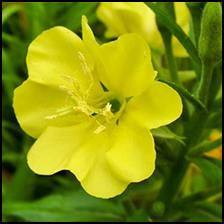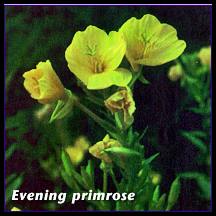
Evening Primrose
SCIENTIFIC NAME:(Oenothera biennis)
Evening Primrose has a long history of medicinal use in the Western world. After being used for some time by Native Americans, it crossed the Atlantic in the early 17th century and was categorized by one of the first significant European botanists, the Englishman John Goodyer.
Evening primrose is a flowering plant native to North America that now grows throughout much of Europe and parts of Asia. It blooms every other year and its large, fragrant yellow flowers open at dusk and remain open through the night. In Germany, the plant is called Night Candle for this reason. The oil extracted from the ripe seeds and the fresh plant is used in herbal remedies.
The oil from the seeds and plant contains gamma-linolenic acid (GLA), an omega-6 fatty acid. GLA is thought to play a key role in many body processes. But omega-6 fatty acids are also abundant in nuts and vegetable oils in the form of linoleic acid. The body can convert linoleic acid to GLA and other omega 6 fatty acids as needed. Note that omega-6 fatty acids are different from omega-3 fatty acids . Omega-3 fatty acids can be found in fish and fish oils.
Common Names:
Cowslip, Fever Plant, King’s Cure-all, Night Candle, Night Willow, Sun Drop, Scabish

Uses:
Evening primrose is promoted as an herbal remedy for a very broad range of conditions, including dermatitis, premenstrual syndrome, menopausal symptoms, eczema, inflammation, hyperactivity in children, high cholesterol, asthmatic cough, upset stomach, psoriasis, rheumatoid arthritis, Irritable Bowel Syndrome and diabetic nerve damage. Some proponents also believe the plant has anti-cancer properties. Some claims of evening Primrose's health benefits are based on the fact that its oil contains the omega-6 fatty acid GLA, as noted above.Originally, herbalists would prepare a tea from the entire Evening Primrose plant. These days however, our job is made much easier by having Evening Primrose oil readily available from most herbal stores. However, some conditions respond better when the actual plant is used as in teas, tinctures and such.
Evening Primrose definitely soothes the stomach, especially in tea form, being relaxing, antispasmodic, slightly astringent and somewhat mucilaginous, very healing and gently tonic. This is an ideal remedy for dyspepsia with gastric inflammation, a large, coated tongue and an overall sense of gloom. It is especially useful where there is a spasmodic cough/asthma and/or pelvic fullness and reproductive irritation.
This herb has an evenly balanced blend of energies and tastes as to be nearly neutral and gently stimulate the solar plexus and revitalize the whole body. Other herbs of this class include Lemon Balm and St. John’s Wort. Note that both of these plants, like Evening Primrose, are very useful for both anxiety and depression. They significantly affect both the solar plexus and the heart. These are balancing remedies for the mind, spirit and body.
Applications:
Infusion:
1-3 tsp whole plant in infusion per day
Tincture:
1-15 drops of whole plant tincture up to 3-4 times per day Instructions for making tinctures are given on the Methods page.
Tea:
Leaves and stems are used to brew tea. Drink 2 to 4 cups a day as needed. Add honey or lemon if desired.
Oil:
Can be bought as an oil or gelcap. Follow directions on bottle.
Warnings:
Evening Primrose is a relatively safe substance to take. The worst side effects to have been reported are mainly headaches and stomach pain. However, you should always consult you doctor before starting any herbal treatment.
With any herb, there is the risk of an allergic reaction. Small children and pregnant women should use additional caution when considering the use of herbal remedies.





